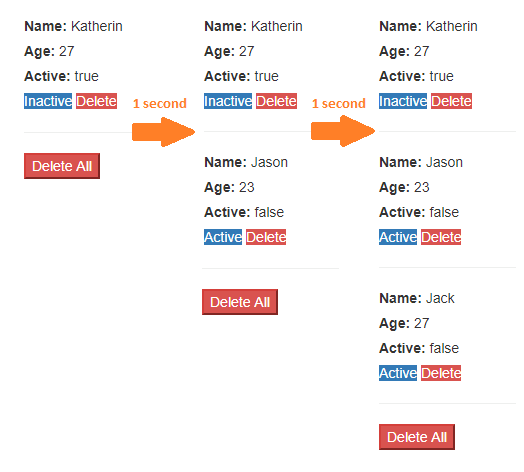In this tutorial, we're gonna build a full Reactive Application in which, Spring WebFlux, Spring Data Reactive Cassandra are used for backend, and Angular, RxJS, EventSource are on client side.
Related Posts:
- SpringData Reactive Cassandra Repositories | SpringBoot
- Introduction to RxJS – Extensions for JavaScript Reactive Streams
- Angular 4 + Spring Boot + Cassandra CRUD example
I. Technologies
- Java 1.8
- Maven 3.3.9
- Spring Tool Suite 3.9.0.RELEASE
- Spring Boot 2.0.0.RELEASE
- Angular 5
- RxJS 5.1.0
- Cassandra 3.9.0
II. Overview
1. Full Stack Architecture

2. Reactive Spring Boot Server
2.1 Dependency
<dependency> <groupId>org.springframework.boot</groupId> <artifactId>spring-boot-starter-data-cassandra-reactive</artifactId> </dependency>
<dependency>
<groupId>org.springframework.boot</groupId>
<artifactId>spring-boot-starter-webflux</artifactId>
</dependency>
2.2 Reactive Repository
We just need to create an interface that extends ReactiveCrudRepository to do CRUD operations for a specific type. This repository follows reactive paradigms and uses Project Reactor types (Flux, Mono) which are built on top of Reactive Streams.
import org.springframework.data.repository.reactive.ReactiveCrudRepository;
import reactor.core.publisher.Flux;
public interface ReactiveCustomerRepository extends ReactiveCrudRepository{
Flux findByLastname(String lastname);
@Query("SELECT * FROM customer WHERE firstname = ?0 and lastname = ?1")
Mono findByFirstnameAndLastname(String firstname, String lastname);
// for deferred execution
Flux findByLastname(Mono lastname);
Mono findByFirstnameAndLastname(Mono firstname, String lastname);
}2.3 Activate reactive Spring Data Cassandra
Support for reactive Spring Data is activated through an @EnableReactiveCassandraRepositories annotation:
import org.springframework.context.annotation.Configuration;
import org.springframework.data.cassandra.config.AbstractReactiveCassandraConfiguration;
import org.springframework.data.cassandra.config.SchemaAction;
import org.springframework.data.cassandra.repository.config.EnableReactiveCassandraRepositories;
@Configuration
@EnableReactiveCassandraRepositories
public class CassandraReactiveConfig extends AbstractReactiveCassandraConfiguration {
@Override
protected String getKeyspaceName() {
return "javasampleapproach";
}
@Override
public SchemaAction getSchemaAction() {
return SchemaAction.RECREATE;
}
}
2.4 Call Reactive Repository
We can forward the reactive parameters provided by Spring Web Reactive, pipe them into the repository, get back a Flux/Mono and then work with result in reactive way.
import java.util.UUID;
import com.datastax.driver.core.utils.UUIDs;
import reactor.core.publisher.Flux;
import reactor.core.publisher.Mono;
@CrossOrigin(origins = "http://localhost:4200")
@RestController
public class CustomerController {
@Autowired
ReactiveCustomerRepository customerRepository;
@GetMapping("/customers")
public Flux getAllCustomers() {
return customerRepository.findAll();
}
@PostMapping("/customers/create")
public Mono createCustomer(@Valid @RequestBody Customer customer) {
customer.setId(UUIDs.timeBased());
customer.setActive(false);
return customerRepository.save(customer);
}
@PutMapping("/customers/{id}")
public Mono> updateCustomer(@PathVariable("id") UUID id, @RequestBody Customer customer) {
return customerRepository.findById(id).flatMap(customerData -> {
customerData.setName(customer.getName());
customerData.setAge(customer.getAge());
customerData.setActive(customer.isActive());
return customerRepository.save(customerData);
}).map(updatedcustomer -> new ResponseEntity<>(updatedcustomer, HttpStatus.OK))
.defaultIfEmpty(new ResponseEntity<>(HttpStatus.NOT_FOUND));
}
@DeleteMapping("/customers/{id}")
public ResponseEntity deleteCustomer(@PathVariable("id") UUID id) {
try {
customerRepository.deleteById(id).subscribe();
} catch (Exception e) {
return new ResponseEntity<>("Fail to delete!", HttpStatus.EXPECTATION_FAILED);
}
return new ResponseEntity<>("Customer has been deleted!", HttpStatus.OK);
}
@DeleteMapping("/customers/delete")
public ResponseEntity deleteAllCustomers() {
try {
customerRepository.deleteAll().subscribe();
} catch (Exception e) {
return new ResponseEntity<>("Fail to delete!", HttpStatus.EXPECTATION_FAILED);
}
return new ResponseEntity<>("All customers have been deleted!", HttpStatus.OK);
}
@GetMapping("/customers/findbyage")
public Flux findByAge(@RequestParam int age) {
return customerRepository.findByAge(age);
}
}
In the rest controller methods which are annotated by @RequestMapping, we have used some methods of autowired repository which are implemented interface ReactiveCrudRepository:
public interface ReactiveCrudRepository<T, ID> extends Repository<T, ID> {
<S extends T> Mono<S> save(S entity);
Mono<T> findById(ID id);
Flux<T> findAll();
Mono<Void> deleteById(ID id);
Mono<Void> deleteAll();
// ...
}And findByAge method that we create in our interface ReactiveCustomerRepository:
public interface ReactiveCustomerRepository extends ReactiveCrudRepository<Customer, UUID>{
Flux<Customer> findByAge(int age);
}Remember that we want to connect to backend from a client application deployed in a different port, so we must enable CORS using @CrossOrigin annotation.
3. Reactive Angular Client
3.1 Reactive Service
This service interacts with the backend using Server-Sent Events.
import { Injectable, NgZone } from '@angular/core';
import { HttpClient, HttpRequest } from '@angular/common/http';
import { Observable } from 'rxjs/Observable';
import * as EventSource from 'eventsource';
import { Customer } from './customer';
@Injectable()
export class CustomerService {
private baseUrl = 'http://localhost:8080/api/customers';
private customersList: Customer[] = new Array();
private customersListSearch: Customer[] = new Array();
constructor(private http: HttpClient, private zone: NgZone) {
}
createCustomer(customer: Object): Observable<Object> {
return this.http.post(`${this.baseUrl}` + `/create`, customer);
}
updateCustomer(id: string, value: any): Observable<Object> {
return this.http.put(`${this.baseUrl}/${id}`, value);
}
deleteCustomer(id: string): Observable<any> {
return this.http.delete(`${this.baseUrl}/${id}`, { responseType: 'text' });
}
getCustomersList(): Observable<any> {
this.customersList = new Array();
return Observable.create((observer) => {
const eventSource = new EventSource(`${this.baseUrl}`);
eventSource.onmessage = (event) =>
this.zone.run(() => {
console.log('eventSource.onmessage: ', event);
const json = JSON.parse(event.data);
this.customersList.push(new Customer(json['id'], json['name'], json['age'], json['active']));
observer.next(this.customersList);
});
eventSource.onerror = (error) => observer.error('eventSource.onerror: ' + error);
return () => eventSource.close();
});
}
deleteAll(): Observable<any> {
return this.http.delete(`${this.baseUrl}` + `/delete`, { responseType: 'text' });
}
findCustomers(age): Observable<any> {
this.customersListSearch = new Array();
return Observable.create((observer) => {
const eventSource = new EventSource(`${this.baseUrl}` + `/findbyage?age=` + age);
eventSource.onmessage = (event) =>
this.zone.run(() => {
console.log('eventSource.onmessage: ', event);
const json = JSON.parse(event.data);
this.customersListSearch.push(new Customer(json['id'], json['name'], json['age'], json['active']));
observer.next(this.customersListSearch);
});
eventSource.onerror = (error) => observer.error('eventSource.onerror: ' + error);
return () => eventSource.close();
});
}
}Whenever we receive an event through the EventSource object, onmessage() is invoked. That's where we parse data and update item list.
Using RxJS Observable object, any Observer that subscribed to the Observable we created can receive events when the item list gets updated (when calling observer.next(...)).
We have to instantiate a NgZone and call zone.run(callback) to help Angular notify when change happens.
3.2 Reactive Component
This Component calls Service above and keep result inside an Observable object:
import { Component, OnInit } from '@angular/core';
import { Observable } from 'rxjs/Observable';
import { CustomerService } from '../customer.service';
import { Customer } from '../customer';
@Component({
selector: 'customers-list',
templateUrl: './customers-list.component.html',
styleUrls: ['./customers-list.component.css']
})
export class CustomersListComponent implements OnInit {
customers: Observable;
constructor(private customerService: CustomerService) { }
ngOnInit() {
this.reloadData();
}
deleteCustomers() {
this.customerService.deleteAll()
.subscribe(
data => console.log(data),
error => console.log('ERROR: ' + error)
);
}
reloadData() {
this.customers = this.customerService.getCustomersList();
}
}In HTML template, we add async pipe that subscribes to the Observable and update component whenever a new event comes:
<div *ngFor="let customer of customers | async">
<customer-details [customer]='customer'></customer-details>
</div>
<div>
<button type="button" class="button btn-danger" (click)='deleteCustomers()'>Delete All</button>
</div>III. Practice
0. Set up Cassandra
Open Cassandra CQL Shell:
-
Create Cassandra keyspace with name javasampleapproach:
create keyspace javasampleapproach with replication={'class':'SimpleStrategy', 'replication_factor':1}; -
Create customer table for javasampleapproach keyspace:
use javasampleapproach;
CREATE TABLE customer(
id timeuuid PRIMARY KEY,
name text,
age int,
active boolean
);
-
Because we use repository finder method on
agefield, so we need to create an index onagecolumn:CREATE INDEX ON javasampleapproach.customer (age);1. Reactive Spring Boot Server
1.1 Project Structure
Class Customer corresponds to document in customer collection.
ReactiveCustomerRepository is an interface extends ReactiveCrudRepository, will be autowired in CustomerController for implementing repository methods.
CustomerController is a REST Controller which has request mapping methods for RESTful requests such as:
getAll,create,update,deleteCustomers.-
Dependencies for Spring Boot WebFlux and Spring Data Cassandra in pom.xml.
1.2 Dependency
<dependency>
<groupId>org.springframework.boot</groupId>
<artifactId>spring-boot-starter-data-cassandra-reactive</artifactId>
</dependency>
<dependency>
<groupId>org.springframework.boot</groupId>
<artifactId>spring-boot-starter-webflux</artifactId>
</dependency>
1.3 Data Model
package com.javasampleapproach.reactive.cassandra.model;
import java.util.UUID;
import org.springframework.data.cassandra.core.mapping.PrimaryKey;
import org.springframework.data.cassandra.core.mapping.Table;
@Table
public class Customer {
@PrimaryKey
private UUID id;
private String name;
private int age;
private boolean active;
public Customer() {
}
public Customer(String name, int age) {
this.name = name;
this.age = age;
}
public UUID getId() {
return id;
}
public void setId(UUID id) {
this.id = id;
}
public void setName(String name) {
this.name = name;
}
public String getName() {
return this.name;
}
public void setAge(int age) {
this.age = age;
}
public int getAge() {
return this.age;
}
public boolean isActive() {
return active;
}
public void setActive(boolean active) {
this.active = active;
}
@Override
public String toString() {
return "Customer [id=" + id + ", name=" + name + ", age=" + age + ", active=" + active + "]";
}
}
1.4 Reactive Repository
package com.javasampleapproach.reactive.cassandra.repo;
import java.util.UUID;
import org.springframework.data.repository.reactive.ReactiveCrudRepository;
import com.javasampleapproach.reactive.cassandra.model.Customer;
import reactor.core.publisher.Flux;
public interface ReactiveCustomerRepository extends ReactiveCrudRepository{
Flux findByAge(int age);
}
1.5 Enable reactive Spring Data Cassandra
package com.javasampleapproach.reactive.cassandra.config;
import org.springframework.context.annotation.Configuration;
import org.springframework.data.cassandra.config.AbstractReactiveCassandraConfiguration;
import org.springframework.data.cassandra.config.SchemaAction;
import org.springframework.data.cassandra.repository.config.EnableReactiveCassandraRepositories;
@Configuration
@EnableReactiveCassandraRepositories
public class CassandraReactiveConfig extends AbstractReactiveCassandraConfiguration {
@Override
protected String getKeyspaceName() {
return "javasampleapproach";
}
@Override
public SchemaAction getSchemaAction() {
return SchemaAction.RECREATE;
}
}
1.6 REST Controller
package com.javasampleapproach.reactive.cassandra.controller;
import java.time.Duration;
import java.util.UUID;
import javax.validation.Valid;
import org.springframework.beans.factory.annotation.Autowired;
import org.springframework.http.HttpStatus;
import org.springframework.http.ResponseEntity;
import org.springframework.web.bind.annotation.CrossOrigin;
import org.springframework.web.bind.annotation.DeleteMapping;
import org.springframework.web.bind.annotation.GetMapping;
import org.springframework.web.bind.annotation.PathVariable;
import org.springframework.web.bind.annotation.PostMapping;
import org.springframework.web.bind.annotation.PutMapping;
import org.springframework.web.bind.annotation.RequestBody;
import org.springframework.web.bind.annotation.RequestMapping;
import org.springframework.web.bind.annotation.RequestParam;
import org.springframework.web.bind.annotation.RestController;
import com.javasampleapproach.reactive.cassandra.model.Customer;
import com.javasampleapproach.reactive.cassandra.repo.ReactiveCustomerRepository;
import com.datastax.driver.core.utils.UUIDs;
import reactor.core.publisher.Flux;
import reactor.core.publisher.Mono;
@CrossOrigin(origins = "http://localhost:4200")
@RestController
@RequestMapping(value = "/api")
public class CustomerController {
@Autowired
ReactiveCustomerRepository customerRepository;
@GetMapping("/customers")
public Flux getAllCustomers() {
System.out.println("Get all Customers...");
return customerRepository.findAll().delayElements(Duration.ofMillis(1000));
}
@PostMapping("/customers/create")
public Mono createCustomer(@Valid @RequestBody Customer customer) {
System.out.println("Create Customer: " + customer.getName() + "...");
customer.setId(UUIDs.timeBased());
customer.setActive(false);
return customerRepository.save(customer);
}
@PutMapping("/customers/{id}")
public Mono> updateCustomer(@PathVariable("id") UUID id, @RequestBody Customer customer) {
System.out.println("Update Customer with ID = " + id + "...");
return customerRepository.findById(id).flatMap(customerData -> {
customerData.setName(customer.getName());
customerData.setAge(customer.getAge());
customerData.setActive(customer.isActive());
return customerRepository.save(customerData);
}).map(updatedcustomer -> new ResponseEntity<>(updatedcustomer, HttpStatus.OK))
.defaultIfEmpty(new ResponseEntity<>(HttpStatus.NOT_FOUND));
}
@DeleteMapping("/customers/{id}")
public ResponseEntity deleteCustomer(@PathVariable("id") UUID id) {
System.out.println("Delete Customer with ID = " + id + "...");
try {
customerRepository.deleteById(id).subscribe();
} catch (Exception e) {
return new ResponseEntity<>("Fail to delete!", HttpStatus.EXPECTATION_FAILED);
}
return new ResponseEntity<>("Customer has been deleted!", HttpStatus.OK);
}
@DeleteMapping("/customers/delete")
public ResponseEntity deleteAllCustomers() {
System.out.println("Delete All Customers...");
try {
customerRepository.deleteAll().subscribe();
} catch (Exception e) {
return new ResponseEntity<>("Fail to delete!", HttpStatus.EXPECTATION_FAILED);
}
return new ResponseEntity<>("All customers have been deleted!", HttpStatus.OK);
}
@GetMapping("/customers/findbyage")
public Flux findByAge(@RequestParam int age) {
return customerRepository.findByAge(age).delayElements(Duration.ofMillis(1000));
}
}
To make the result live, we use delayElements(). It causes a delayed time between 2 events.
2. Reactive Angular Client
2.1 User Interface
2.2 Project Structure
In this example, we have:
– 4 components: customers-list, customer-details, create-customer, search-customers.
– 4 modules: FormsModule, HttpClientModule, AppRoutingModule.
– customer.ts: class Customer (id, name, age, active).
– customer.service.ts: Service for HttpClient methods.
2.3 AppModule
app.module.ts
import { AppRoutingModule } from './app-routing.module';
import { BrowserModule } from '@angular/platform-browser';
import { NgModule } from '@angular/core';
import { FormsModule } from '@angular/forms';
import { HttpClientModule } from '@angular/common/http';
import { AppComponent } from './app.component';
import { CreateCustomerComponent } from './customers/create-customer/create-customer.component';
import { CustomerDetailsComponent } from './customers/customer-details/customer-details.component';
import { CustomersListComponent } from './customers/customers-list/customers-list.component';
import { SearchCustomersComponent } from './customers/search-customers/search-customers.component';
import { CustomerService } from './customers/customer.service';
@NgModule({
declarations: [
AppComponent,
CreateCustomerComponent,
CustomerDetailsComponent,
CustomersListComponent,
SearchCustomersComponent
],
imports: [
BrowserModule,
FormsModule,
AppRoutingModule,
HttpClientModule
],
providers: [CustomerService],
bootstrap: [AppComponent]
})
export class AppModule { }
2.4 Model
customer.ts
export class Customer {
id: string;
name: string;
age: number;
active: boolean;
constructor(id?: string, name?: string, age?: number, active?: boolean) {
this.id = id;
this.name = name;
this.age = age;
this.active = active;
}
}
2.5 Service
customer.service.ts
import { Injectable, NgZone } from '@angular/core';
import { HttpClient, HttpRequest } from '@angular/common/http';
import { Observable } from 'rxjs/Observable';
import * as EventSource from 'eventsource';
import { Customer } from './customer';
@Injectable()
export class CustomerService {
private baseUrl = 'http://localhost:8080/api/customers';
private customersList: Customer[] = new Array();
private customersListSearch: Customer[] = new Array();
constructor(private http: HttpClient, private zone: NgZone) {
}
createCustomer(customer: Object): Observable<Object> {
return this.http.post(`${this.baseUrl}` + `/create`, customer);
}
updateCustomer(id: string, value: any): Observable<Object> {
return this.http.put(`${this.baseUrl}/${id}`, value);
}
deleteCustomer(id: string): Observable<any> {
return this.http.delete(`${this.baseUrl}/${id}`, { responseType: 'text' });
}
getCustomersList(): Observable<any> {
this.customersList = new Array();
return Observable.create((observer) => {
const eventSource = new EventSource(`${this.baseUrl}`);
eventSource.onmessage = (event) =>
this.zone.run(() => {
console.log('eventSource.onmessage: ', event);
const json = JSON.parse(event.data);
this.customersList.push(new Customer(json['id'], json['name'], json['age'], json['active']));
observer.next(this.customersList);
});
eventSource.onerror = (error) => observer.error('eventSource.onerror: ' + error);
return () => eventSource.close();
});
}
deleteAll(): Observable<any> {
return this.http.delete(`${this.baseUrl}` + `/delete`, { responseType: 'text' });
}
findCustomers(age): Observable<any> {
this.customersListSearch = new Array();
return Observable.create((observer) => {
const eventSource = new EventSource(`${this.baseUrl}` + `/findbyage?age=` + age);
eventSource.onmessage = (event) =>
this.zone.run(() => {
console.log('eventSource.onmessage: ', event);
const json = JSON.parse(event.data);
this.customersListSearch.push(new Customer(json['id'], json['name'], json['age'], json['active']));
observer.next(this.customersListSearch);
});
eventSource.onerror = (error) => observer.error('eventSource.onerror: ' + error);
return () => eventSource.close();
});
}
}
2.6 Components
2.6.1 CustomerDetailsComponent
customer-details.component.ts
import { Component, OnInit, Input } from '@angular/core';
import { CustomerService } from '../customer.service';
import { Customer } from '../customer';
import { CustomersListComponent } from '../customers-list/customers-list.component';
@Component({
selector: 'customer-details',
templateUrl: './customer-details.component.html',
styleUrls: ['./customer-details.component.css']
})
export class CustomerDetailsComponent implements OnInit {
@Input() customer: Customer;
constructor(private customerService: CustomerService, private listComponent: CustomersListComponent) { }
ngOnInit() {
}
updateActive(isActive: boolean) {
this.customerService.updateCustomer(this.customer.id,
{ name: this.customer.name, age: this.customer.age, active: isActive })
.subscribe(
data => {
console.log(data);
this.customer = data as Customer;
},
error => console.log(error)
);
}
deleteCustomer() {
this.customerService.deleteCustomer(this.customer.id)
.subscribe(
data => {
console.log(data);
this.listComponent.reloadData();
},
error => console.log(error)
);
}
}
customer-details.component.html
<div *ngIf="customer">
<div>
<label>Name: </label> { { customer.name}}
</div>
<div>
<label>Age: </label> { { customer.age}}
</div>
<div>
<label>Active: </label> { { customer.active}}
</div>
<span class="button is-small btn-primary" *ngIf='customer.active' (click)='updateActive(false)'>Inactive</span>
<span class="button is-small btn-primary" *ngIf='!customer.active' (click)='updateActive(true)'>Active</span>
<span class="button is-small btn-danger" (click)='deleteCustomer()'>Delete</span>
<hr/>
</div>2.6.2 CustomersListComponent
customers-list.component.ts
import { Component, OnInit } from '@angular/core';
import { Router } from '@angular/router';
import { Observable } from 'rxjs/Observable';
import { CustomerService } from '../customer.service';
import { Customer } from '../customer';
@Component({
selector: 'customers-list',
templateUrl: './customers-list.component.html',
styleUrls: ['./customers-list.component.css']
})
export class CustomersListComponent implements OnInit {
customers: Observable;
constructor(private customerService: CustomerService, private router: Router) { }
ngOnInit() {
this.reloadData();
}
deleteCustomers() {
this.customerService.deleteAll()
.subscribe(
data => {
console.log(data);
this.navigateToAdd();
},
error => console.log('ERROR: ' + error)
);
}
reloadData() {
this.customers = this.customerService.getCustomersList();
}
navigateToAdd() {
this.router.navigate(['add']);
}
}customers-list.component.html
<br/>
<div *ngFor="let customer of customers | async" style="width: 300px;">
<customer-details [customer]='customer'></customer-details>
</div>
<div>
<button type="button" class="button btn-danger" (click)='deleteCustomers()'>Delete All</button>
</div>2.6.3 CreateCustomerComponent
create-customer.component.ts
import { Component, OnInit } from '@angular/core';
import { FormsModule } from '@angular/forms';
import { Customer } from '../customer';
import { CustomerService } from '../customer.service';
@Component({
selector: 'create-customer',
templateUrl: './create-customer.component.html',
styleUrls: ['./create-customer.component.css']
})
export class CreateCustomerComponent implements OnInit {
customer: Customer = new Customer();
submitted = false;
constructor(private customerService: CustomerService) { }
ngOnInit() {
}
newCustomer(): void {
this.submitted = false;
this.customer = new Customer();
}
save() {
this.customerService.createCustomer(this.customer)
.subscribe(data => console.log(data), error => console.log(error));
this.customer = new Customer();
}
onSubmit() {
this.submitted = true;
this.save();
}
}
create-customer.component.html
<h3>Create Customer</h3>
<div [hidden]="submitted" style="width: 300px;">
<form (ngSubmit)="onSubmit()">
<div class="form-group">
<label for="name">Name</label> <input type="text"
class="form-control" id="name" required [(ngModel)]="customer.name"
name="name">
</div>
<div class="form-group">
<label for="age">Age</label> <input type="text"
class="form-control" id="age" required [(ngModel)]="customer.age"
name="age">
</div>
<button type="submit" class="btn btn-success">Submit</button>
</form>
</div>
<div [hidden]="!submitted">
<h4>You submitted successfully!</h4>
<button class="btn btn-success" (click)="newCustomer()">Add</button>
</div>2.6.4 SearchCustomersComponent
search-customers.component.ts
import { Component, OnInit } from '@angular/core';
import { Observable } from 'rxjs/Observable';
import { CustomerService } from '../customer.service';
import { Customer } from '../customer';
@Component({
selector: 'search-customers',
templateUrl: './search-customers.component.html',
styleUrls: ['./search-customers.component.css']
})
export class SearchCustomersComponent implements OnInit {
customers: Observable;
age: number;
constructor(private customerService: CustomerService) { }
ngOnInit() {
this.age = 0;
}
search() {
this.customers = this.customerService.findCustomers(this.age);
}
}search-customers.component.html
<h3>Find Customers By Age</h3>
<input type="text" [(ngModel)]="age" placeholder="enter age" class="input">
<button class="btn btn-success" (click)="search()">Search</button>
<hr />
<ul>
<li *ngFor="let customer of customers | async">
<h5> { { customer.name}} - Age: { { customer.age}} - Active: { { customer.active}}</h5>
</li>
</ul>2.7 AppRoutingModule
app-routing.module.ts
import { CreateCustomerComponent } from './customers/create-customer/create-customer.component';
import { CustomersListComponent } from './customers/customers-list/customers-list.component';
import { SearchCustomersComponent } from './customers/search-customers/search-customers.component';
import { NgModule } from '@angular/core';
import { RouterModule, Routes } from '@angular/router';
const routes: Routes = [
{ path: '', redirectTo: 'customers', pathMatch: 'full' },
{ path: 'customers', component: CustomersListComponent },
{ path: 'add', component: CreateCustomerComponent },
{ path: 'search', component: SearchCustomersComponent },
];
@NgModule({
imports: [RouterModule.forRoot(routes)],
exports: [RouterModule]
})
export class AppRoutingModule { }
2.8 App Component
app.component.ts
import { Component } from '@angular/core';
@Component({
selector: 'app-root',
templateUrl: './app.component.html',
styleUrls: ['./app.component.css']
})
export class AppComponent {
title = 'JavaSampleApproach';
description = 'Reactive-Angular-Cassandra';
constructor() { }
}app.component.html
<div class="container-fluid">
<div style="color: blue;">
<h1> { { title}}</h1>
<h3> { { description}}</h3>
</div>
<nav>
<a routerLink="customers" class="btn btn-primary active" role="button" routerLinkActive="active">Customers</a>
<a routerLink="add" class="btn btn-primary active" role="button" routerLinkActive="active">Add</a>
<a routerLink="search" class="btn btn-primary active" role="button" routerLinkActive="active">Search</a>
</nav>
<router-outlet></router-outlet>
</div>3. Run & Check Result
-
Build and Run Spring Boot project with commandlines:
mvn clean installandmvn spring-boot:run. Run the Angular App with command:
npm start.Open browser with url
http://localhost:4200/, add some Customers.Click on Customers tab, each Customer displays one after another with 1s delayed time.
- Click on Search tab, search '27', the result shows each Customer one after another with 1s delayed time.











Top comments (0)